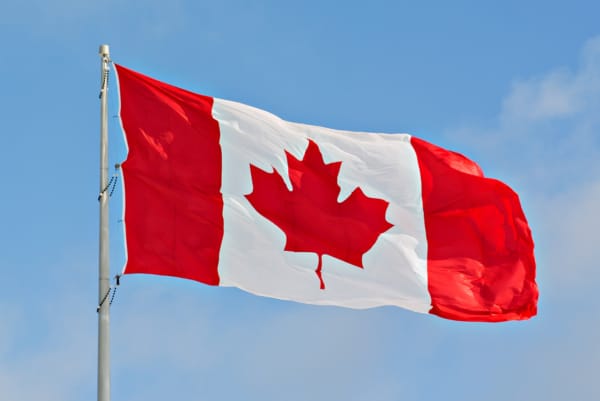Learn about NFPA and Canadian fire and building codes and standards vs. the U.S.
When U.S. businesses look to expand onto the global stage, our neighbor to the north is the first place many set their sights. Forecast by the Economic Intelligence Unit as the #1 place to do business among G7 countries for the next five years, expanding into Canada makes sense for many reasons—including a strategic location, low trade and tax costs, strong investment stability, and few cultural or language barriers.
But while many familiar National Fire Protection Association (NFPA) codes and standards apply in Canada, American companies can find themselves in hot water if they don’t follow Canada’s unique fire and building codes as well.
This blog explains Canada codes, digging into how they differ from the U.S. and when NFPA applies. We will also offer guidance on the best way to ensure compliance for American companies that cross our northern border.
Canada publishes model codes independent of NFPA and the ICC
Before we get started, here’s a fundamental concept to understand: while Canadian fire and building codes reference nearly 90 NFPA codes and standards, the overarching Canadian model codes are completely separate from those in the U.S.
Just like U.S. jurisdictions implement model codes created by a national organization—NFPA and the International Code Council (ICC)—a Canadian national organization spearheads the development of model codes in Canada.
But unlike the independent, non-profit organizations in the U.S., the National Research Council of Canada (NRC) that publishes the Canada code is a government organization.
For more than 80 years, NRC has attempted to harmonize building and safety regulations across Canada by collaborating with its provinces and territories to develop model building, fire, plumbing, and energy codes. The Council of Canadian Fire Marshals and Fire Commissioners also actively participate in developing codes and standards relating to fire safety.
The Canadian Commission on Building and Fire Codes (CCBFC), an independent committee of volunteers established by the NRC, provides direction and oversight of code development. NRC hosts the system and is involved throughout, from managing funding to supporting committee work with the latest technical information and expertise. It also publishes the codes in English and French, which must then be adopted by a regulatory authority to become law.
Codes are either adopted outright by jurisdictions or amended or supplemented to suit regional needs and then published as territorial or provincial codes. Enforcement is also the responsibility of the provincial or territorial Authority Having Jurisdiction (AHJ). To assist in the application of Canadian codes, explanatory material is published as user guides.
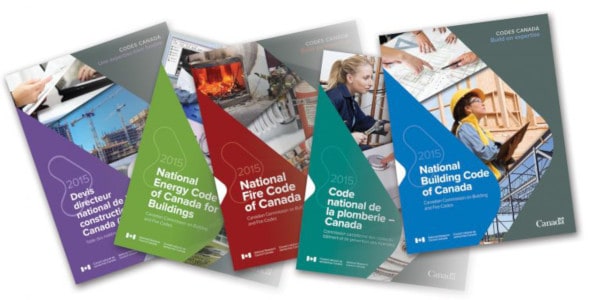
Canadian model codes are updated approximately every five years. Proposals to change or amend them may be made at the national level through the Canadian Codes Center (CCC). The latest edition is Codes Canada 2015, which includes:
- National Building Code (NBC). Addresses the design and construction of new buildings and the substantial renovation of existing buildings.
- National Fire Code (NFC). Provides minimum fire safety requirements for buildings, structures, and areas where hazardous materials are used and addresses fire protection and fire prevention in facilities’ ongoing operation.
- National Plumbing Code (NPC). Covers the design and installation of plumbing systems in buildings and facilities.
- National Energy Code for Buildings (NECB). Provides minimum energy efficiency requirements for the design and construction of new buildings and additions.
Codes Canada 2020 has been released this year, and work has already begun on Codes Canada 2025.
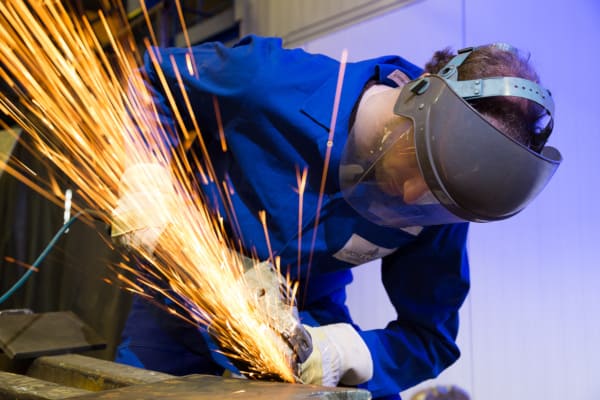
Are Canadian codes different from those in the US?
Put simply, the answer is yes—but not too different. While the code development organizations in Canada and the U.S. are entirely independent of each other, fire and life safety are fairly standard across borders. As a result, code changes in the U.S. are often also proposed for adoption in Canada, either immediately or down the road.
Existing code requirements are similar in both countries, although the specific philosophies behind them may differ slightly. For instance, Canadian model codes require a somewhat larger safety zone than U.S. codes for hot work. Canada’s model codes also establish different parameters for isolation distances and personal protective equipment (PPE) than NFPA 70E: Standard for Electrical Safety in the Workplace.

Canadian regulatory authorities also control the final acceptance of fire and life safety products like fire doors and insist on changes if they don’t comply with their country’s requirements. When choosing products for a Canadian structure, keep in mind that there are multiple variations of marks that indicate products are “listed” by UL, the global safety certification agency. Products carrying UL marks for Canada have been evaluated to Canadian safety requirements, while a combination mark indicates compliance with both Canadian and U.S. standards. Products that only bear the American mark may not meet Canadian standards.
Shayne Mintz, NFPA’s Regional Director for Canada, advises American businesses to contact the local provincial or territorial authority in areas they target to ensure they are aware of their code requirements. As head of NFPA’s Canadian operations, Mintz supports users of NFPA codes and standards up north. He also aims to promote fire and life safety by providing and advocating consensus codes and standards, research, training, and education across Canada.
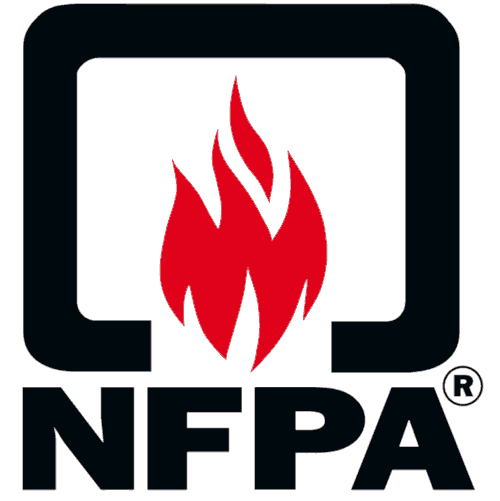
The role of NFPA codes and standards in Canada
So, how does NFPA fit into Canadian building and fire codes? Instead of reinventing the wheel and incurring unnecessary expense, Canadian code makers often take advantage of the expertise and painstaking research and development process NFPA puts into creating codes and standards for niche areas.
Nearly 90 NFPA codes and standards are referenced in Canada’s model codes, including NFPA 13: Standard for the Installation of Sprinkler Systems, NFPA 25: Standard for the Inspection, Testing, and Maintenance of Water-Based Fire Protection Systems, NFPA 96: Standard for Ventilation Control and Fire Protection of Commercial Cooking Operations, and NFPA 303: Fire Protection Standard for Marinas and Boatyards. When referenced, NFPA codes and standards become legally enforceable parts of adopted codes.
Two Canadian jurisdictions also have independently adopted broader NFPA codes. The province of Prince Edward Island utilizes NFPA 1: Fire Code and NFPA 101: Life Safety Code, and the province of Newfoundland and Labrador uses NFPA 101. While regulations in Canada’s model codes take precedence, NFPA expands on Canadian requirements.
NFPA rules have long incorporated the metric system of measurement used in Canada and most other parts of the world, making international usage effortless. Nearly 10 NFPA standards have also been translated into French for use in French-speaking parts of Canada, Mintz said.
NFPA’s CodeFinder tool makes it easy to discover which NFPA codes and standards are referenced in model codes adopted by each Canadian province and territory.
Canadian versions of NFPA’s public education resources and materials that include metric measurements, Canadian spellings, Canadian data, and French-Canadian translations (when available) are available here.
Under Mintz’s leadership, NFPA has also adapted U.S. fire safety programs for Canadian use. Most prominently, they include FireSmart Canada, which helps communities fight wildfires, and an Electric, Hybrid, and Fuel Cell Vehicle Safety Training Program for Emergency Responders hosted by NFPA and the Council of Canadian Fire Marshals and Fire Commissioners.
Watch this video to learn more about the role of NFPA in Canada:
Changes in Codes Canada 2020—and beyond
Fire and life safety code is a “living” entity – it’s continually evolving to adapt to modern needs. Businesses looking to set up shop in Canada should stay informed about key fire and life safety issues that impact upcoming fire and building codes:
1. For the first time since a separate National Farm Building Code was published in 1995, Codes Canada 2020 makes substantive updates to regulations concerning farm buildings.
Requirements for large farm buildings (defined as more than 600 square meters) will be integrated into the National Fire Code and National Building Code for the first time. The changes are designed to improve safety in farm buildings and reflect changing requirements as buildings increase in size, complexity, and usage.
In recent years, farm buildings have been used in Canada for everything from cannabis production to wedding chapels. The updated code will address such concerns as life safety, building size, building materials, means of egress, access, design loads, seismic design, ventilation, and restrictions on adjacent buildings.
2. Climate change adaptation is another focus of Canadian code makers. As climate change makes extreme weather more frequent and destructive, NRC scientists aim to ensure Canada’s built environment is ready.
Prominent changes to Canada’s 2020 model codes stem from a $42.5 million, five-year research program investigating how changing weather and the “new normal” that follows may affect stresses on buildings, roads, wastewater, transit, bridges, and other infrastructure.
The 2020 code upgrades building requirements for wind resistance and how buildings bear snow loads, add rules for rainwater collection, mandate automatic backflow systems to reduce flooding risk, and add new standards for windows, exterior insulation, fire tests, air barriers, and asphalt shingles. More significant changes related to climate change are expected in the 2025 code cycle.
3. Improved accessibility, egress, and visitability are also ongoing priorities for Canadian code makers, with several low- and no-cost updates already introduced in Codes Canada 2015.
Both the 2020 and 2025 code cycles are expected to add regulations that improve access and use of buildings for people of all ages and abilities. The new codes respond to requests from the provinces and territories for input and direction in this area.

4. As similar battles wage in the U.S., NFPA has teamed with the Home Fire Sprinkler Coalition Canada and other organizations to push for fire sprinkler requirements in Canadian residential construction. While fire sprinklers are required in multi-story residential buildings throughout Canada, currently only the province of British Columbia maintains any fire sprinkler requirements for single-family homes.
In many cases, municipalities are prohibited from adding regulations that supersede the greater province’s minimum requirements; for instance, since Ontario does not require fire sprinklers in new homes, individual municipalities can’t implement laws that do.
After efforts to create laws requiring sprinklers in new homes were met with strong resistance from homebuilders complaining about added costs, the fire safety organizations have emphasized community fire protection modeling. Side-by-side burn demonstrations educate homeowners about the effectiveness of fire sprinklers. The organizations also educate builders about incentives and trade-offs that often become available from local jurisdictions when sprinklers are installed voluntarily, such as reduced lot sizes and relaxed fire hydrant requirements.
5. The 2020 codes will allow the construction of tall wood buildings, doubling the permissible height from 6 to 12 stories. The code calls for the use of mass timber construction, which combines strength and fire resistance ratings.
6. After a series of horrific accidents, Canada Code 2020 prohibits the use of wired glass, which has been the only fire-rated glazing product recognized by Canadian model codes. Commonly used in doors and windows in schools, offices, and hospitals across Canada, wired glass is manufactured primarily as a fire retardant, with wire mesh inlaid in the glass to prevent it from breaking under stress or when exposed to high temperatures.
The Canadian General Standards Board removed wired glass from its national building standards in 2017 due to its lack of impact resistance and a high risk of serious injuries when broken. In the U.S., the International Building Code (IBC) has banned the use of wired glass in populated areas of a structure since 2006. The updated Canadian code will require fire-rated alternatives to wired glass to be third-party certified and labeled for use in Canada. Filmed wired glass may be permitted if it comes with UL certification and permanent UL marking on the glass.
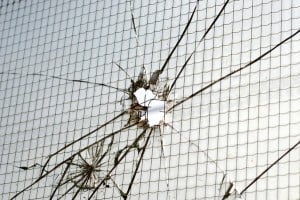
Follow NFPA standards for Canada and Canada’s unique model codes to avoid costly mistakes
Expanding your business into the U.S.’ friendly neighbor to the north can make sense for many reasons. Staying informed about differences between U.S. and Canada building and fire codes—and learning which NFPA codes apply to your operation—helps American companies avoid costly mistakes or operational delays.
Contact the local provincial or territorial authority for more information about building and fire codes in the country’s specific region!
This blog was originally posted at blog.qrfs.com. If this article helped you, check us out at Facebook.com/QuickResponseFireSupply or on Twitter @QuickResponseFS.


